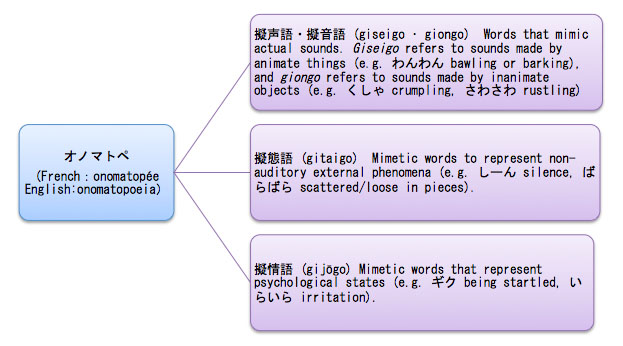ことば・文化ノート2
オノマトペ Onomatopoeia
オノマトペ (onomato•pée in French; onomatopoeia in English) are sound symbolic words. While English has words such as bow-wow, creak, ding, and pitapat, Japanese is abundant with such expressions, even extending to mimetic words that “imitate” soundless states or events. Generally, the Japanese sound symbolic vocabulary is classified into the following three types:
•擬声語(ぎせいご)・擬音語(ぎおんご) (giseigo • giongo) Words that mimic actual sounds. Giseigo refers to sounds made by animate things (e.g., わんわん a baby bawling or a dog barking), and giongo refers to sounds made by inanimate objects (e.g., くしゃ crumpling, さわさわ rustling)
•擬態語(ぎたいご) (gitaigo) Mimetic words to represent non-auditory external phenomena (e.g., しーん silence, ばらばら scattered in pieces).
•擬情語 (きじょうご )(gijōgo) Mimetic words that represent psychological states (e.g.,ギク being startled, いらいら irritation).
Note: The division between the above types is not always clear. For example, a mimetic word may refer to one’s inner emotion as well as to an external expression.
In 坊っちゃん, sound symbolic words that mimic actual sounds are typically used independently to describe scenes, such as シャー (the sound of water flowing while wringing a towel) and ガラガラ (rattling of things falling down). If these words are used in sentences, they function as adverbs, often taking the particle と (typically for action) or sometimes に (typically for results). For example, わんわん(と)泣(な)く to bawl, きらきら(と)光(ひか)る to sparkle, ひらひら(と)舞(ま)う to flutter (in the air), かちかちに凍(こお)る to be frozen hard.
There are some patterns in sound-meaning relationships. The vowelう often represents psychological states (e.g., うきうき buoyant and cheerful), and いrepresents tenseness (e.g., きりきり sharp pain). A long vowel denotes prolongation or continuity and the んending denotes prolonged resonance (e.g., ずどーん prolonged bang). Voiced consonants tend to represent stronger, bigger, rougher actions and states. For example, the smooth rustling of tree leaves would be かさかさ, but a heavy or rough rustling would be がさがさ. Pleasant dampness of the skin would be しっとり, but uncomfortable dampness from sweating would be じっとり. Repetition represents repetitive sounds or movements (e.g., ごろごろ rumbling, tumbling).
参考文献 References
Hamano, Shoko (1998). The sound-symbolic system of Japanese. Stanford, CA: CSLI.
Makino, Seiichi, and Michio Tsutsui (1989). Dictionary of Basic Japanese Grammar, Tokyo: The Japan Times. pp.50-56.
Shibatani, Masayoshi (1990). The Languages of Japan. Cambridge: Cambridge University Press. pp.153-157
Yamaguchi, Toshiko (2007). Japanese Linguistics: An Introduction. London & New York: Continuum. pp.63-71.












